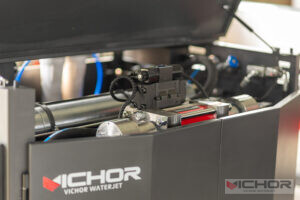
How Does Water Cutting Technology Deliver Precision and Efficiency in Cutting?
Water cutting technology, often referred to as water jet cutting, is a versatile and innovative method that uses high-pressure water streams to cut through a wide range of materials. This technology has gained significant traction in various industries due to its precision, environmental benefits, and adaptability. In this article, we will delve into the intricacies of water cutting technology, exploring its fundamental principles, advantages, applications, comparisons with other methods, and future trends. By understanding these aspects, you can appreciate why water cutting technology is revolutionizing modern manufacturing and fabrication processes.
Water cutting technology operates by propelling water at extremely high pressures—often exceeding 60,000 psi—through a small nozzle to create a focused jet capable of slicing through materials like metal, stone, glass, and composites. The process can be enhanced with abrasive additives for tougher materials, making it a flexible solution for diverse needs. As industries seek more efficient and sustainable cutting methods, water cutting technology stands out for its ability to reduce waste, minimize heat-affected zones, and handle complex designs. This article will provide a comprehensive overview, ensuring you grasp the full potential of this advanced technique.
What is Water Cutting Technology?
Water cutting technology is a non-thermal cutting process that utilizes a high-velocity stream of water, sometimes mixed with abrasives, to erode materials precisely. The core components include a high-pressure pump, an intensifier, a nozzle, and a control system. The pump pressurizes water, which is then forced through the nozzle at speeds capable of cutting through various thicknesses and types of materials. This method is highly regarded for its cold-cutting nature, meaning it does not generate heat that could alter material properties, making it ideal for sensitive applications. The evolution of water cutting technology has made it a go-to solution in sectors requiring high accuracy and minimal material distortion.
The history of water cutting technology dates back to the 1970s, when it was initially developed for industrial use. Over the decades, advancements in pump design and control software have enhanced its efficiency and accessibility. Today, water cutting technology is employed in everything from aerospace to art, demonstrating its versatility. By avoiding thermal distortion, it preserves the integrity of materials, reducing the need for secondary processing. This aspect of water cutting technology not only saves time but also lowers production costs, contributing to its growing adoption across global markets.
How Does Water Cutting Technology Work?
The operation of water cutting technology begins with a high-pressure pump that pressurizes water to levels between 30,000 and 90,000 psi. This pressurized water is then directed through a small orifice in the nozzle, creating a supersonic jet that can reach speeds of up to 900 meters per second. For cutting harder materials like metals or ceramics, abrasive particles such as garnet are introduced into the stream, amplifying the cutting power. The abrasive water cutting technology variant allows for precise cuts in thick or durable substrates without compromising quality.
A key element in water cutting technology is the control system, which often uses computer numerical control (CNC) to guide the nozzle along predetermined paths. This automation ensures repeatability and accuracy, enabling complex shapes and intricate designs to be cut with tolerances as tight as 0.1 mm. The absence of heat in the process means that materials do not experience hardening or warping, which is common in laser or plasma cutting. Moreover, water cutting technology produces a narrow kerf width, minimizing material waste and enhancing efficiency. The entire process is supported by filtration systems to maintain water purity and recycling mechanisms to promote sustainability.
Advantages of Using Water Cutting Technology
One of the primary benefits of water cutting technology is its ability to cut without generating heat, thus eliminating heat-affected zones (HAZ) that can weaken materials or require additional finishing. This cold-cutting capability makes water cutting technology suitable for temperature-sensitive materials like plastics, composites, and certain metals. Additionally, water cutting technology is environmentally friendly, as it typically uses water and natural abrasives, reducing hazardous waste compared to methods involving chemicals or oils.
Another advantage of water cutting technology is its versatility; it can handle a vast array of materials, from soft foams to hard alloys, without the need for tool changes. This flexibility streamlines production processes and reduces downtime. Water cutting technology also excels in precision, allowing for detailed cuts and tight tolerances that are essential in industries such as medical device manufacturing or automotive engineering. Furthermore, the process is safe, as it does not produce toxic fumes or radiation, aligning with workplace safety standards. The economic efficiency of water cutting technology is evident in its low operational costs and high material utilization rates, making it a cost-effective long-term investment.
Applications of Water Cutting Technology in Various Industries
Water cutting technology finds applications across numerous sectors due to its adaptability and precision. In the aerospace industry, it is used to cut composite materials and titanium components, where precision and lack of thermal damage are critical. The automotive sector employs water cutting technology for shaping gaskets, interior panels, and metal parts, benefiting from its ability to produce clean edges without deburring. In architecture and construction, water cutting technology is utilized for cutting stone, tiles, and glass, enabling intricate designs and custom fittings.
The art and design world also leverages water cutting technology to create detailed sculptures and patterns in materials like wood and metal. In the food industry, a specialized form of water cutting technology is used for slicing products like pastries and frozen foods, ensuring hygienic and precise cuts without contamination. The medical field applies water cutting technology to manufacture implants and devices from biocompatible materials, where accuracy is paramount. These diverse applications highlight how water cutting technology can be tailored to meet specific industry needs, driving innovation and efficiency.
Comparing Water Cutting Technology with Other Cutting Methods
When compared to traditional cutting methods like laser, plasma, or mechanical cutting, water cutting technology offers distinct advantages. Unlike laser cutting, which relies on heat and can cause material deformation, water cutting technology maintains material integrity, making it better for heat-sensitive applications. Plasma cutting, while fast, often results in wider kerfs and heat-affected zones, whereas water cutting technology provides finer cuts with minimal waste. Mechanical methods, such as sawing or milling, involve physical contact that can lead to tool wear and material stress, but water cutting technology is a non-contact process, reducing wear and tear.
However, water cutting technology may have slower cutting speeds for some materials compared to lasers or plasma, and initial setup costs can be higher due to the need for high-pressure systems. Despite this, the long-term benefits of water cutting technology, such as reduced secondary processing and versatility, often outweigh these drawbacks. In terms of environmental impact, water cutting technology is superior because it uses water—a renewable resource—and generates less pollution. This comparison underscores why many industries are shifting towards water cutting technology for sustainable and precise cutting solutions.

Future Trends in Water Cutting Technology
The future of water cutting technology is poised for exciting advancements, driven by innovations in automation, software, and sustainability. Emerging trends include the integration of artificial intelligence (AI) and machine learning to optimize cutting paths and predict maintenance needs, enhancing the efficiency of water cutting technology. Developments in pump technology aim to achieve higher pressures with lower energy consumption, making water cutting technology more accessible and cost-effective. Additionally, there is a growing focus on recycling water and abrasives in water cutting technology systems to minimize environmental footprint.
Another trend is the expansion of water cutting technology into new markets, such as renewable energy, where it can be used for cutting components in solar panels or wind turbines. Research into hybrid systems that combine water cutting technology with other methods, like ultrasound, could further improve precision and speed. As industries increasingly prioritize green manufacturing, water cutting technology is expected to play a pivotal role due to its eco-friendly attributes. Overall, the ongoing evolution of water cutting technology promises to make it even more integral to modern industrial processes, fostering innovation and sustainability.
In conclusion, water cutting technology represents a significant leap forward in cutting methodologies, offering precision, versatility, and environmental benefits. From its fundamental workings to its broad applications and future potential, this technology continues to transform how materials are processed across industries. By adopting water cutting technology, businesses can achieve higher efficiency, reduce waste, and meet stringent quality standards. As we look ahead, the continued refinement of water cutting technology will likely unlock new possibilities, solidifying its place as a cornerstone of advanced manufacturing.
Frequently Asked Questions About Water Cutting Technology
Q1: What is water cutting technology commonly used for?
A1: Water cutting technology is commonly used for precision cutting in industries such as aerospace, automotive, and architecture. It handles materials like metals, composites, stone, and glass, enabling intricate designs without heat damage.
Q2: How does water cutting technology differ from laser cutting?
A2: Unlike laser cutting, which uses heat and can cause material distortion, water cutting technology is a cold-cutting process that relies on high-pressure water jets. This makes it ideal for heat-sensitive materials and reduces the risk of altering material properties.
Q3: Is water cutting technology environmentally friendly?
A3: Yes, water cutting technology is considered environmentally friendly because it primarily uses water and natural abrasives, producing minimal hazardous waste. Many systems also incorporate water recycling to conserve resources.
Q4: What materials can be cut with water cutting technology?
A4: Water cutting technology can cut a wide range of materials, including metals, ceramics, plastics, rubber, stone, and composites. The addition of abrasives allows it to handle harder substances effectively.
Q5: What are the maintenance requirements for water cutting technology systems?
A5: Maintenance for water cutting technology systems typically involves regular inspection of pumps, nozzles, and filters to ensure optimal performance. This includes replacing worn parts and cleaning to prevent clogging, which helps extend the system’s lifespan.
continue reading



